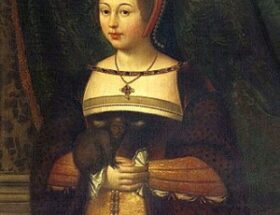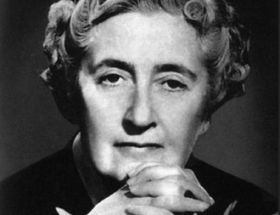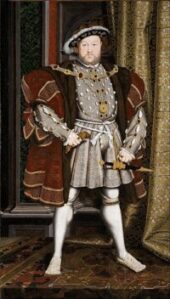
Early life
James Cook was born on 7 November 1728 in the village of Marton in Yorkshire and baptised on 14 November in the parish church of St Cuthbert, where his name can be seen in the church register.
He was the second of eight children of James Cook, a Scottish farm labourer from Ednam in Roxburghshire, and his wife, Grace Pace, from Thornaby-on-Tees.
In 1736, his family moved to Airey Holme farm at Great Ayton, where his father’s employer, Thomas Skottowe, paid for him to attend the local school. In 1741, he began work for his father, who had been promoted to farm manager. Despite not being formally educated he became capable in mathematics, astronomy and charting by the time of his Endeavour voyage.
For leisure, he would climb a nearby hill, Roseberry Topping, enjoying the opportunity for solitude.
In 1745, James moved to the fishing village of Staithes, to be apprenticed as a shop boy to grocer and haberdasher William Sanderson. Historians have speculated that this is where James first felt the lure of the sea while gazing out of the shop window.
He proved unsuited for shop work and in 1746 travelled to the nearby port town of Whitby to be introduced to Sanderson‘s friends John and Henry Walker, who were prominent local ship-owners in the coal trade.
James was taken on as a merchant navy apprentice in their small fleet of vessels, plying coal along the English coast. His first assignment was aboard the collier Freelove and he spent several years on this and various other coasters, sailing between the Tyne and London. As part of his apprenticeship, James applied himself to the study of algebra, geometry, trigonometry, navigation and astronomy—all skills he would need one day to command his own ship.
With his three-year apprenticeship completed, James began working on trading ships in the Baltic Sea. After passing his examinations in 1752, he soon progressed through the merchant navy ranks, starting with his promotion in that year to mate aboard the collier brig Friendship.
In 1755, within a month of being offered command of this vessel, he volunteered for service in the Royal Navy, when Britain was re-arming for what was to become the Seven Years’ War. Despite the need to start back at the bottom of the naval hierarchy, James realised his career would advance more quickly in military service and entered the Navy at Wapping on 17 June 1755.
James Cook married Elizabeth Batts, the daughter of Samuel Batts, keeper of the Bell Inn in Wapping and one of his mentors, on 21 December 1762 at St Margaret’s Church, Barking, Essex.
The couple had six children: James (b.1763), Nathaniel (b.1764), Elizabeth (1767–1771), Joseph (1768–1768), George (1772–1772) and Hugh (b.1776).
Royal Navy career
James Cook’s first posting was with HMS Eagle, serving as able seaman and master’s mate under Captain Joseph Hamar for his first year aboard, and Captain Hugh Palliser thereafter.
In October and November 1755, he took part in Eagle’s capture of one French warship and the sinking of another, following which he was promoted to boatswain in addition to his other duties. His first temporary command was in March 1756 when he was briefly master of Cruizer, a small cutter attached to Eagle while on patrol.
In June 1757 James Cook formally passed his master’s examinations at Trinity House, Deptford, qualifying him to navigate and handle a ship of the King’s fleet. He then joined the frigate HMS Solebay as master under Captain Robert Craig.
During the Seven Years’ War, James served in North America as master aboard the fourth-rate Navy vessel HMS Pembroke. With others in Pembroke‘s crew, he took part in the major amphibious assault that captured the Fortress of Louisbourg from the French in 1758 and in the siege of Quebec City in 1759.
Throughout his service he demonstrated a talent for surveying and cartography and was responsible for mapping much of the entrance to the Saint Lawrence River during the siege, thus allowing General Wolfe to make his famous stealth attack during the 1759 Battle of the Plains of Abraham.
Cook‘s surveying ability was also put to use in mapping the jagged coast of Newfoundland in the 1760s, aboard HMS Grenville. He surveyed the northwest stretch in 1763 and 1764, the south coast between the Burin Peninsula and Cape Ray in 1765 and 1766, and the west coast in 1767.
At this time, James employed local pilots to point out the “rocks and hidden dangers” along the south and west coasts. During the 1765 season, four pilots were engaged: John Beck for the coast west of “Great St Lawrence”, Morgan Snook for Fortune Bay, John Dawson for Connaigre and Hermitage Bay, and John Peck for the “Bay of Despair”.
While in Newfoundland, James also conducted astronomical observations, in particular of the eclipse of the sun on 5 August 1766. By obtaining an accurate estimate of the time of the start and finish of the eclipse, and comparing these with the timings at a known position in England it was possible to calculate the longitude of the observation site in Newfoundland. This result was communicated to the Royal Society in 1767.
His five seasons in Newfoundland produced the first large-scale and accurate maps of the island’s coasts and were the first scientific, large scale, hydrographic surveys to use precise triangulation to establish land outlines. They also gave James his mastery of practical surveying and brought him to the attention of the Admiralty and Royal Society at a crucial moment both in his career and in the direction of British overseas discovery.
His maps were used into the 20th century, with copies being referenced by those sailing Newfoundland’s waters for 200 years.
Following on from his exertions in Newfoundland, James Cook wrote that he intended to go not only “farther than any man has been before me, but as far as I think it is possible for a man to go”.
First voyage (1768-1771)
On 25 May 1768, the Admiralty commissioned James to command a scientific voyage to the Pacific Ocean. The purpose of the voyage was to observe and record the 1769 transit of Venus across the Sun which, when combined with observations from other places, would help to determine the distance of the Earth from the Sun.
James was promoted to lieutenant to grant him sufficient status to take the command. For its part, the Royal Society agreed that he would receive a one hundred guinea gratuity in addition to his Naval pay.
The expedition sailed aboard HMS Endeavour, departing England on 26 August 1768. James and his crew rounded Cape Horn and continued westward across the Pacific, arriving at Tahiti on 13 April 1769, where the observations of the transit were made.
However, the result of the observations was not as conclusive or accurate as had been hoped. Once the observations were completed, James opened the sealed orders, which were additional instructions from the Admiralty for the second part of his voyage: to search the south Pacific for signs of the postulated rich southern continent of Terra Australis.
James then sailed to New Zealand where he mapped the complete coastline, making only some minor errors. With the aid of Tupaia, a Tahitian priest who had joined the expedition, James was the first European to communicate with the Māori. He then voyaged west, reaching the southeastern coast of Australia on 19 April 1770, and in doing so his expedition became the first recorded Europeans to have encountered its eastern coastline.
On 23 April, he made his first recorded direct observation of indigenous Australians at Brush Island near Bawley Point, noting in his journal: “… and were so near the Shore as to distinguish several people upon the Sea beach they appear’d to be of a very dark or black Colour but whether this was the real colour of their skins or the C[l]othes they might have on I know not.”
On 29 April, James and his crew made their first landfall on the mainland of the continent at a place now known as the Kurnell Peninsula. He originally named the area “Stingray Bay”, but later crossed this out and named it “Botany Bay” after the unique specimens retrieved by the botanists Joseph Banks and Daniel Solander. It is here that James made first contact with an aboriginal tribe known as the Gweagal.
After his departure from Botany Bay, he continued northwards. He stopped at Bustard Bay on 23 May 1770. On 24 May, Cook, Banks and others went ashore. Continuing north, on 11 June a mishap occurred when Endeavour ran aground on a shoal of the Great Barrier Reef, and then “nursed into a river mouth on 18 June 1770”.
The ship was badly damaged and the voyage was delayed almost seven weeks while repairs were carried out on the beach. The voyage then continued and at about midday on 22 August 1770, they reached the northernmost tip of the coast, which James named it York Cape.
Leaving the east coast, James turned west and nursed his battered ship through the dangerously shallow waters of Torres Strait. Searching for a vantage point, he saw a steep hill on a nearby island from the top of which he hoped to see “a passage into the Indian Seas”.
He returned to England via Batavia (modern Jakarta, Indonesia), where many of his crew succumbed to malaria, and then the Cape of Good Hope, arriving at the island of Saint Helena on 30 April 1771. The ship finally reached England on 12 July 1771, with James going to Deal.
Second voyage (1772-1775)
Shortly after his return from the first voyage, James was promoted in August 1771 to the rank of commander. In 1772, he was commissioned to lead another scientific expedition on behalf of the Royal Society, to search for the hypothetical Terra Australis.
On his first voyage, James had demonstrated by circumnavigating New Zealand that it was not attached to a larger landmass to the south. Although he charted almost the entire eastern coastline of Australia, showing it to be continental in size, the Terra Australis was believed to lie further south. Despite this evidence to the contrary, Alexander Dalrymple and others of the Royal Society still believed that a massive southern continent should exist.
James commanded HMS Resolution on this voyage, while Tobias Furneaux commanded its companion ship, HMS Adventure. Cook’s expedition circumnavigated the globe at an extreme southern latitude, becoming one of the first to cross the Antarctic Circle on 17 January 1773.
In the Antarctic fog, Resolution and Adventure became separated. Furneaux made his way to New Zealand, where he lost some of his men during an encounter with Māori, and eventually sailed back to Britain, while James continued to explore the Antarctic, reaching 71°10’S on 31 January 1774.
James almost encountered the mainland of Antarctica but turned towards Tahiti to resupply his ship. He then resumed his southward course in a second fruitless attempt to find the supposed continent. On this leg of the voyage, he brought a young Tahitian named Omai, who proved to be somewhat less knowledgeable about the Pacific than Tupaia had been on the first voyage. On his return voyage to New Zealand in 1774, James landed at the Friendly Islands, Easter Island, Norfolk Island, New Caledonia, and Vanuatu.
Before returning to England, James made a final sweep across the South Atlantic from Cape Horn and surveyed, mapped, and took possession for Britain of South Georgia. He also discovered and named Clerke Rocks and the South Sandwich Islands (“Sandwich Land”). He then turned north to South Africa and from there continued back to England. His reports upon his return home put to rest the popular myth of Terra Australis.
Upon his return, James was promoted to the rank of post-captain and given an honorary retirement from the Royal Navy, with a posting as an officer of the Greenwich Hospital. He reluctantly accepted, insisting that he be allowed to quit the post if an opportunity for active duty should arise.
His fame extended beyond the Admiralty: he was made a Fellow of the Royal Society and awarded the Copley Gold Medal for completing his second voyage without losing a man to scurvy.
Third voyage (1776-1779)
On his last voyage, James Cook again commanded HMS Resolution, while Captain Charles Clerke commanded HMS Discovery.
The trip’s principal goal was to locate a Northwest Passage around the American continent. After dropping Omai at Tahiti, James travelled north and in 1778 became the first European to begin formal contact with the Hawaiian Islands.
After his initial landfall in January 1778 at Waimea harbour, Kauai, James named the archipelago the “Sandwich Islands” after the fourth Earl of Sandwich.
In North America
From the Sandwich Islands, James sailed north and then northeast to explore the west coast of North America north of the Spanish settlements in Alta California. He sighted the Oregon coast at approximately 44°30′ north latitude, naming Cape Foulweather, after the bad weather which forced his ships south to about 43° north before they could begin their exploration of the coast northward.
He unknowingly sailed past the Strait of Juan de Fuca and soon after entered Nootka Sound on Vancouver Island. He anchored near the First Nations village of Yuquot. His two ships remained in Nootka Sound from 29 March to 26 April 1778, in what James called Ship Cove, now Resolution Cove, at the south end of Bligh Island.
Relations between Cook‘s crew and the people of Yuquot were cordial although sometimes strained. In trading, the people of Yuquot demanded much more valuable items than the usual trinkets that had been acceptable in Hawaii. Metal objects were much desired, but the lead, pewter and tin traded at first soon fell into disrepute. The most valuable items which the British received in trade were sea otter pelts.
After leaving Nootka Sound in search of the Northwest Passage, James explored and mapped the coast all the way to the Bering Strait, on the way identifying what came to be known as Cook Inlet in Alaska.
In a single visit, he charted the majority of the North American northwest coastline on world maps for the first time, determined the extent of Alaska, and closed the gaps in Russian (from the west) and Spanish (from the south) exploratory probes of the northern limits of the Pacific.
By the second week of August 1778, Cook was through the Bering Strait, sailing into the Chukchi Sea. He headed northeast up the coast of Alaska until he was blocked by sea ice at a latitude of 70°44′ north. He then sailed west to the Siberian coast and then southeast down the Siberian coast back to the Bering Strait.
By early September 1778 he was back in the Bering Sea to begin the trip to the Sandwich Islands.
Return to Hawaii
James returned to Hawaii in 1779. After sailing around the archipelago for eight weeks, he made landfall at Kealakekua Bay on Hawai’i Island, largest island in the Hawaiian Archipelago.
Cook’s arrival coincided with the Makahiki, a Hawaiian harvest festival of worship for the Polynesian god Lono. Coincidentally the form of Cook‘s ship, HMS Resolution, or more particularly the mast formation, sails and rigging, resembled certain significant artefacts that formed part of the season of worship.
Similarly, Cook‘s clockwise route around the island of Hawaii before making landfall resembled the processions that took place in a clockwise direction around the island during the Lono festivals.
It has been argued (most extensively by Marshall Sahlins) that such coincidences were the reasons for Cook‘s initial deification by some Hawaiians who treated him as an incarnation of Lono.
Death
After a month’s stay, James attempted to resume his exploration of the northern Pacific. Shortly after leaving Hawaii Island, Resolution‘s foremast broke, so the ships returned to Kealakekua Bay for repairs.
Tensions rose and a number of quarrels broke out between the Europeans and Hawaiians at Kealakekua Bay, including the theft of wood from a burial ground under Cook’s orders. An unknown group of Hawaiians took one of Cook’s small boats.
The evening when the cutter was taken, the people had become “insolent” even with threats to fire upon them. James attempted to kidnap and ransom the King of Hawaiʻi, Kalaniʻōpuʻu.
On 14 February 1779, James Cook marched through the village to retrieve the king. He took the king by his own hand and led him away. One of Kalaniʻōpuʻu’s favourite wives, Kanekapolei, and two chiefs approached the group as they were heading to the boats.
They pleaded with the king not to go. An old kahuna (priest), chanting rapidly while holding out a coconut, attempted to distract Cook and his men as a large crowd began to form at the shore. At this point, the king began to understand that James was his enemy.
As James turned his back to help launch the boats, he was struck on the head by the villagers and then stabbed to death as he fell on his face. He was first struck on the head with a club by a chief named Kalaimanokahoʻowaha and then stabbed by one of the king’s attendants, Nuaa.
The Hawaiians carried his body away towards the back of the town, still visible to the ship through their spyglass. Four marines, Corporal James Thomas, Private Theophilus Hinks, Private Thomas Fatchett and Private John Allen, were also killed and two others were wounded in the confrontation.



